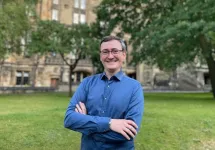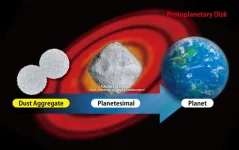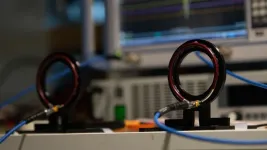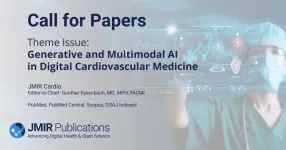Many of these experiments that contribute to the data Hurck is analyzing are conducted at the U.S. Department of Energy's Thomas Jefferson National Accelerator Facility, which is managed and operated by JSA.
“Strangeness hasn't been studied as much because it's quite hard to do,” said Hurck, a research associate at the University of Glasgow. “So far we don't know a lot about these particles because they're hard to find.”
Learning more about strange particles will help physicists learn more about quantum chromodynamics (QCD), the theory used to describe interactions between quarks.
“We look for many different configurations of quarks and attempt to understand how they work to try to figure out something about the underlying nature of this theory,” Hurck said. “QCD is quite fundamental to our everyday world, because in the end it also governs the protons and neutrons that are the fundamental building blocks of matter.”
To learn more about QCD—and our universe—these strange particles need to be produced and measured. That’s where the GlueX experiment comes in.
Sticking down strangeness
In Jefferson Lab’s Experimental Hall D, GlueX is looking for strange and other types of exotic particles. Hall D is a part of the lab’s Continuous Electron Beam Accelerator Facility (CEBAF). CEBAF supports the research of more than 1,800 scientific users worldwide as a DOE Office of Science user facility.
When CEBAF’s electron beam hits a thin diamond target, it produces a linearly polarized photon beam. This photon beam then hits a proton target, which produces a slew of different particles.
“Jefferson Lab’s CEBAF is the only facility in the world right now that has a photon beam that is high energy and stable enough to produce this many strange particles,” Hurck said.
The detector of GlueX is also optimized to measure a wide variety of particles. GlueX will take more and higher quality data than previous experiments searching for the same particles.
“This is really the high-quality data that I will need to do my research project,” Hurck said.
The Jefferson Lab User Organization (JLUO) Board of Directors has awarded the JSA Postdoctoral Prize since 2008. The group represents the scientists who come to Jefferson Lab to conduct research with its unique facilities. The board judges each applicant on their record of accomplishment in physics, proposed use of the research grant, and the likelihood of further accomplishments in the Jefferson Lab research fields.
“I was quite surprised to win, but it’s great. It means that what I've done so far wasn't completely wrong and that my vision for the future is something that other people share and are willing to give money towards,” Hurck said. “I hope it will be good.”
The grant is funded by the JSA Initiatives Fund program, which JSA provides to support programs, initiatives and activities that further the scientific outreach, and promote the science, education and technology missions of Jefferson Lab and benefit the laboratory’s user community.
Double the strange
For his prize-winning project, titled “Strange physics at GlueX,” Hurck will use GlueX data to investigate two types of strange particles.
The first is called strangeonium, which consists of a strange quark and an anti-strange quark. Not many strangeonia have been detected before. Particles that contain strange quarks are difficult to detect. Physicists must perform difficult analyses called partial wave analyses to pick them out of experimental data.
“These types of analyses are quite complicated, quite data intensive, quite computationally intensive, and hard to do,” Hurck said. With Darius Darulis, a Ph.D. student at University of Glasgow, Hurck will perform these analyses on GlueX data to find and study strangeonium.
He also hopes to improve the efficiency of how physicists perform partial wave analyses searching for strangeonium.
“One aspect that I'm personally quite interested in, and that I think is also important going forward, is finding a way to optimize these types of analyses and improve current statistical methods,” Hurck said.
To do so, it’s important for experimentalists like Hurck to get input from theorists. He plans to use the $10,000 JSA Postdoc Prize money to organize a three-day-long workshop dedicated to strange physics. At the workshop, now planned to take place in Glasgow, Scotland, next year, he hopes to facilitate exchange between experimentalists and theorists across labs.
“It's very important that experimentalists measure stuff that's useful to theorists and that theorists try to explain stuff that we measure, so we know we need to bring the communities together,” he said. “I think this workshop will help our efforts.”
While the workshop will have plenty of built-in time for open discussion, Hurck also wants to include presentations on strange physics. For example, he wants to bring in an expert on the second strange particle he’s studying, Lambda(1405).
Lambda(1405), which consists of three quarks instead of two like strangeonium, is extra strange because it exhibits properties that physicists don’t know how to interpret. This could be because Lambda(1405) is actually multiple particles that live close together and interact.
“We want to figure out if Lambda(1405) is one weird particle or is two particles that are constantly quantum mechanically interfering with each other and making weird shapes in our data,” said Hurck, who is collaborating with Nilanga Wickramaarachchi at Catholic University and Reinhard Schumacher at Carnegie Mellon University to investigate Lambda(1405).
Hurck and his collaborators are currently analyzing data collected during phase one of GlueX, which concluded in 2018. Phase two of data collection has been in progress since 2019. Between the two phases, the GlueX collaboration upgraded the experiment’s detector system to optimize its ability to measure strange particles.
Phase two will also produce two to three times more data than phase one, which excites Hurck.
“I really can't wait to get my hands on the full datasets and continue this analysis,” he said. “A lot of the time, it's about gaining enough data to be able to make a conclusive statement.”
By Chris Patrick
-end-
Jefferson Science Associates, LLC, manages and operates the Thomas Jefferson National Accelerator Facility, or Jefferson Lab, for the U.S. Department of Energy's Office of Science. JSA is a wholly owned subsidiary of the Southeastern Universities Research Association, Inc. (SURA).
DOE’s Office of Science is the single largest supporter of basic research in the physical sciences in the United States and is working to address some of the most pressing challenges of our time. For more information, visit https://energy.gov/science.
END






